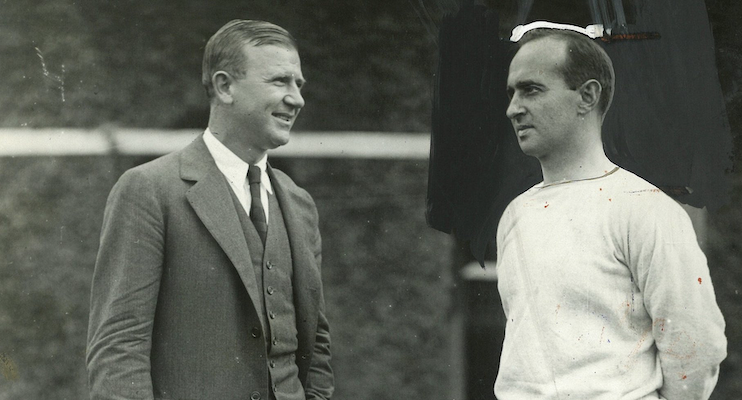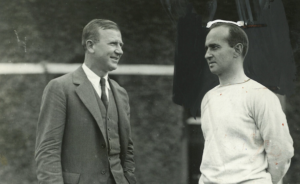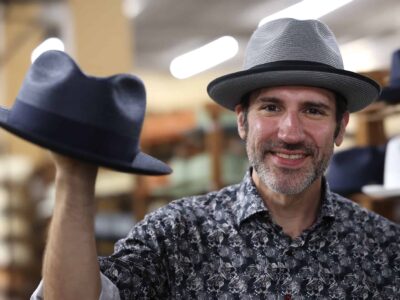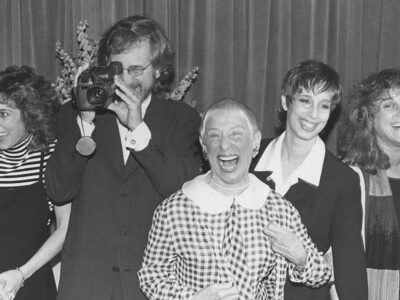When Harvard University named Bill Bingham athletic director–a pioneering college sports role at the time in 1926–the alumnus promised to return the game to student-athletes. He hired Arnold Horween as a head football coach to bring back “fun.” The duo did that and more.
“Before then, much was made about Harvard football players going through the motions, playing without passion, just because that was the path to acclaim and an executive position on Wall Street,” said Zev Eleff, president of Gratz College in Melrose Park, Pa. “Bingham and Horween rearranged things and rewarded hard work and reignited a love for sport–and fun.”
Eleff’s forthcoming book “Dyed in Crimson: Football, Faith, and Remaking Harvard’s America” tells the story, he said, of how those on the periphery of U.S. life can make a significant mark on the mainstream.
In the 1920s, Boston Brahmins–wealthy New Englanders and descendants of the Puritans–ruled Harvard. Football provided a site where a working-class Protestant (Bingham), an Irish Catholic (Eddie Casey, freshman coach) and a Midwestern Jew (Horween) could chip away at that elitism, and replace social status with merit.
“They propel a sleepy team to the Rose Bowl,” Eleff said.
As today, Harvard was on the forefront of elite American culture. That hasn’t changed, and may never, according to Eleff. “What happens at Harvard matters. We tend to think of it as a siloed citadel, unphased by the outside,” he said. “Here’s a history that challenges that assumption.”
Harvard has been in the news recently for offering, reneging and then reoffering a fellowship to an activist accused of anti-Israel bias. A century ago, as a Jewish Chicagoan was putting Harvard football on the map, A. Lawrence Lowell, the university’s president from 1909 to 1933, was imposing quotas on Jewish students.
“It’s important to remember that Harvard, like any university, is a complicated organization with many stakeholders. One decision in one sector often doesn’t reflect the entire university,” Eleff said. “I view all these decisions as choices, or contingencies. Back on the football field in the 1920s, stakeholders–coaches, alumni, presidents–had to make decisions. The same is true now.”
A former captain of the Harvard team, Horween went on to run his family’s successful leather business in Chicago and to serve as a trustee of the Chicago Symphony. He and his brother Ralph played in the National Football League in 1923–a feat that wouldn’t be repeated in the NFL until 2012, when Jewish brothers Mitchell Schwartz and Geoff Schwartz played for the Browns and the Vikings respectively.
Horween had already graduated Harvard when Lowell’s Jewish quotas were instituted. But his prominence in Cambridge, Mass., challenged both Harvard’s president and its elite culture “that intended to keep outsiders, well, out of their school,” Eleff said.
Steven Riess, professor emeritus at Northeastern Illinois University and editor of the 1998 book “Sports and the American Jew,” reviewed the book months ago and sees things differently. “The argument is stronger than the evidence is,” he said.
Harvard and the rest of the Ivy League was becoming increasingly antisemitic at the time, and Riess said it is wishful thinking to view Jewish involvement in Harvard sports as a sign that Jewish fortunes and reputations were changing in Cambridge.
In 1922, a Yale University alumni committee investigated the basketball program after a team of Jewish players from the Atlas Club beat the all-gentile Yale team 42-22 in a charity game in front of the largest crowd in New Haven history, according to Riess’ book. The committee blamed antisemitic coaching, and after Jewish players were recruited, Yale went in 1923 from “the cellar to the championship,” he wrote.
But talented Jewish players were exceptions to the rule, whose athletic prowess overshadowed their Jewish identities rather than being public examples that frustrated antisemites and nudged them toward inclusivity, Riess said.
“Winning superseded everything,” Riess said. “If you had a Jewish star, go get him. But if you were another Jewish guy, they didn’t need you.”
“You had to be very special if you were Jewish,” he added.
Despite significant Jewish athletic achievement in the Olympics, in boxing, and in fencing in the U.S. and in Europe, Jews were not seen in the 1920s as being able bodied. Instead, Jews were seen as physically inept, effeminate, and weak, according to Riess.
Jewish men represented the largest ethnic group that fought for Germany in World War I, for example. “They don’t get credit for it,” Riess said. And some of the top boxers in England in the late 18th century and early 19th century, who subsequently came to America, were Jews. That was also the case with top soccer players in Hungary in the early 20th century.
“Everyone was jealous of these Jews. It was so bad for Hungarians. Jews even outdid them in soccer,” Riess said.
Today, Jews get more credit as athletes, he said. And the public considers more athletes to be Jewish than it did a century ago. Max Baer – who famously beat the German champion Max Schmeling at Yankee Stadium in 1933 – wore a Star of David on his boxing trunks, but since his mother was not Jewish, the public didn’t see him as such, according to Riess.
Eleff’s research for the book led him in a different direction, and he maintains that sports, particularly football at Harvard, did pave the way for Jewish acceptance.
One of the youngest presidents in U.S. higher education – previously chief academic officer of Hebrew Theological College and vice provost of Touro College Illinois – Eleff has long been a big sports fan, particularly football. He stumbled on what would become the basis of the book accidentally, and his wife Melissa suggested pursuing it further.
“I had discovered Horween in the context of a ‘myth.’ People had created a story that he had to change his name when applying to Harvard to avoid the quotas,” Eleff said. “He did change his name, but to play for the NFL Chicago Cardinals, later. When I realized that the story wasn’t true, I knew there was more to it.”
The book afforded him the opportunity to join his passions for football, U.S. Jewish history and religious history.
What does he hope readers take away from the volume? “The role of contingencies,” Eleff said. “History is made by the choices we make. That’s what happened in the sporting lives of Bill Bingham, Arnold Horween and Eddie Casey.”











Comments